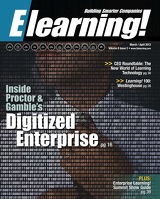Elearning! Magazine: Building Smarter Companies via Learning & Workplace Technologies.
Page 29 of 52
year is to create a better understanding of how the internal training initiatives are impacting the business groups or regions. Ultimately, all training initiatives should be directly linked to business needs." This is also where the relationship part
of Nuclearning becomes important. By leveraging its customer relationships, Westinghouse training can gain a deeper understanding of the operational and busi- ness goals of its customers. This under- standing allows Westinghouse to tightly identify desired training outcomes and to begin the difficult task of measuring the performance and business impacts of train- ing. Training professionals believe that developing the ability to measure training impact at an operational and business level must be one of its next major focus areas.
CHALLENGES
Certainly, there are complications and frus- trations. For instance, there are the chal- lenges of managing the cultural change associated with the greater use of e-learning, including setting expectations with students and their managers about what is required to be a successful e-learning student. This applies to both internal students and to utili- ty customer students. Attacking this issue requires online instructors to be coaches and cheerleaders for both their students and their students' managers. Online instructors must be able to work closely with their online students, recognize their issues, and help them develop their learning skills. Additionally, there is the challenge of
getting all instructors, in all locations, to think of themselves as part of Westinghouse's Corporate University. Convincing instructors and line manage- ment that a center-led organization can be as responsive to local needs as a decentral- ized organization is not always easy. "In creating a center-led organization,
minimal resources have been added," says Aigner. "The challenge is to get the right people in the right place, keeping in mind that each person needs multiple skill sets." At Westinghouse, these and other chal-
lenges will occupy a large part of the training staff's time. Solving these issues will also require a commitment to developing the skill set of the instructors. Again, the university will play a critical role in meeting these challenges.
Handling Change at W Westinghouse
estinghouse representatives were asked to list the most important contributing fac- tors to the great learning culture at Westinghouse, and they all agreed that change management was key. Here's how they responded:
"My group spends a lot of time managing change with our customers," says Pam
Aigner. "That takes leadership from the Westinghouse and customer training organiza- tions. If you have a group of students who are not as comfortable with online learning technology, for example, they may be resistant to its adoption. At the same time, our industry is experiencing some demographic shifts, as a significant percentage of employ- ees are either new to the workforce or nearing retirement, which has added additional challenges. So the need for training has really increased exponentially." Part of Westinghouse Corporate University's change management is communicating
and better understanding the preferred training modalities within the company's various groups. "We are actively trying to figure out what we can do to make training and learn- ing initiatives both effective and efficient. There is definitely an element of change man- agement required for some employees and customers to recognize the benefits of alter- native modes of training," Mike Corrigan says. Adds Aigner: "Our training programs are devised in a certain way based on the outcomes
that we want to have. So we spend a lot of time discussing expectations up front, not just as far as what the students are expected to do, but also their management. Although some of the training takes place online, we find it very important to convey to management they wouldn't interrupt instructor-led training, so they shouldn't interrupt students in an online class." And the training/learning groups also have to manage their own change. "We're constantly getting pushback from managers and customers not wanting to give their
employees as much time in training as we would like, because it eats up their time on their normal job," says Rick Paese. "We've constantly tried to better our product and make training more efficient with Webcasts and computer-based training. And we've done that well." —Jerry Roche
—To participate in "Elearning!" magazine's social community, follow us on Twitter using the handle @2elearning Source: @ConorCusack via Twitter
Elearning! March / April 2012 29
IT PAYS OFF
Besides being named to Elearning! maga- zine's "Learning! 100" list last year, Westinghouse Electric has also won other training awards, specifically: >>Pittsburgh Human Resources Association award in the "People" category;
>>2011 CUBIC Award as runner-up in the "Best New Corporate University" category; and
>>2011 Corporate University Xchange award for "Exemplary Practice in Alignment." "We have seen evidence of better work-
ing knowledge, increased post-training information retention, better integration and synthesis of information, increased problem-solving efficiency, better commu- nication skills, and improvements to pro- cedures as a result of our blended training methods," Aigner concludes. Aigner and her fellow learning profession-
als appreciate the recognition that comes with awards but they know that the real pay- off for training is improved performance for Westinghouse and for its customers. They believe that they are seeing both.
